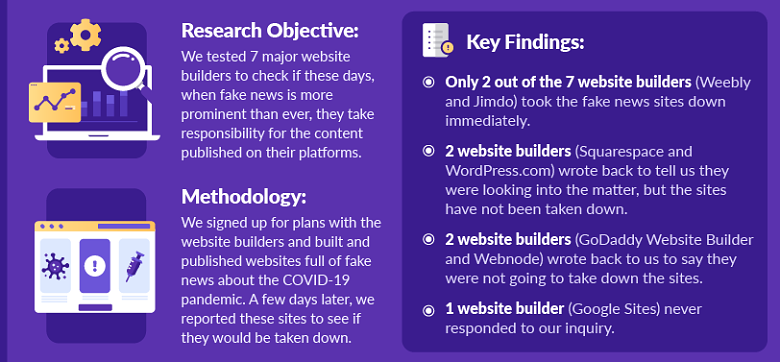
As the world continues to fight the COVID-19 pandemic with lockdown measures, travel restrictions, and vaccination campaigns, misinformation and fake news are as rampant as ever – especially when it comes to coronavirus-related conspiracy theories. This has been a problem since the pandemic began, with outspoken individuals spreading unverified information about the causes, treatments, and severity of the virus. Much of this misinformation has been disseminated online, sowing widespread distrust in scientists, researchers, governments, and public health organizations across the world. Over the past several years, there has been plenty of debate and controversy surrounding the control of fake news online. The internet has become a battleground between free speech and protecting the public good – but where exactly is the line between these two concepts, and who’s responsible for drawing it? We’re in the business of reviewing and recommending website builders, so we wanted to know where they stand. More specifically, we wanted to find out if they assume any responsibility for fake news that’s posted using their services. To answer these questions, we put seven major website builders to the test in order to assess their response – or lack thereof – to COVID-related misinformation.
What Are the Dangers of COVID-19 Misinformation?
Before I get into the details of our research, I want to address the motivation behind it. There are plenty of conflicting viewpoints when it comes to the COVID-19 pandemic, due largely to the fact that our collective understanding of the virus is constantly evolving. This can make it difficult to distinguish between fact and fiction; who’s to say what’s true, when not even the world’s top scientists are always in agreement? Organizations like the WHO and the CDC are constantly revising their recommendations as new information becomes available. Naturally, it’s not easy to keep up with all the changes. That said, certain narratives are objectively false. Amid all the conspiracy theories and political agendas related to the pandemic, fact-checkers have been tackling every new questionable theory that arises, and have definitively proven plenty of them wrong. Note: If you’re ever unsure if something is fake news or legitimate information, there are plenty of reliable ways to find out. For example, you can do a search in Google’s Fact Check Explorer to see results from a variety of reputable sources. The key is to think critically about everything you read online, and to always cross-reference it with trustworthy websites. If you do that, it’s not so difficult to identify fake news. Spreading false information – such as the idea that the virus is exacerbated by 5G, that mass vaccination is a plot to implant microchips in people, or that the entire pandemic is a hoax – is not just irresponsible. It’s unethical and ultimately dangerous. By discouraging people from wearing masks or complying with lockdown restrictions, it puts both them and those around them in danger.
How Online Platforms Handle Misinformation
If you’ve been following the news at all recently, you know that tech giants and social media services are facing tough questions about this topic. At first, many platforms were hesitant to block content and ban users. But after intense media scrutiny and public outrage, some have taken a stronger stance against fake news in the context of the pandemic. For example, Facebook has recently overhauled its policy regarding COVID-related misinformation. Not only does it remove misleading content; it also tells the users who posted, shared, or interacted with that content exactly why it was removed. Twitter has also posted an extremely detailed COVID-19 misleading information policy, which lays out all the types of content that are restricted. It explains what is not a violation of this policy and also what happens if you violate it. Here’s a succinct summary: “You may not use Twitter’s services to share false or misleading information about COVID-19 which may lead to harm.” The actions taken by Facebook and Twitter are especially important because they set a standard for the entire tech industry. Smaller companies – including website builders – may look to them for guidance or a precedent to follow. If that’s the case, then the services we tested shouldn’t have any problem with removing sites that contain blatantly misleading COVID-related content. But as you’ll see in the results section below, it turns out things aren’t quite that simple.How We Researched Website Builders’ Responses to COVID Misinformation
To find out how different website builders deal with reports of misinformation, we created seven websites featuring fake news related to COVID-19. To do so, we used paid accounts (with the exception of Google Sites, which only has a free option). This meant that if the website builders decided to take down our sites, they could lose money. Each site consisted of three main pages: a home page with several headlines promoting conspiracy theories about the pandemic, plus links to the full articles (the same on each site); an “about us” page with a brief summary of the goals of each site (slightly different for each one); and a contact form.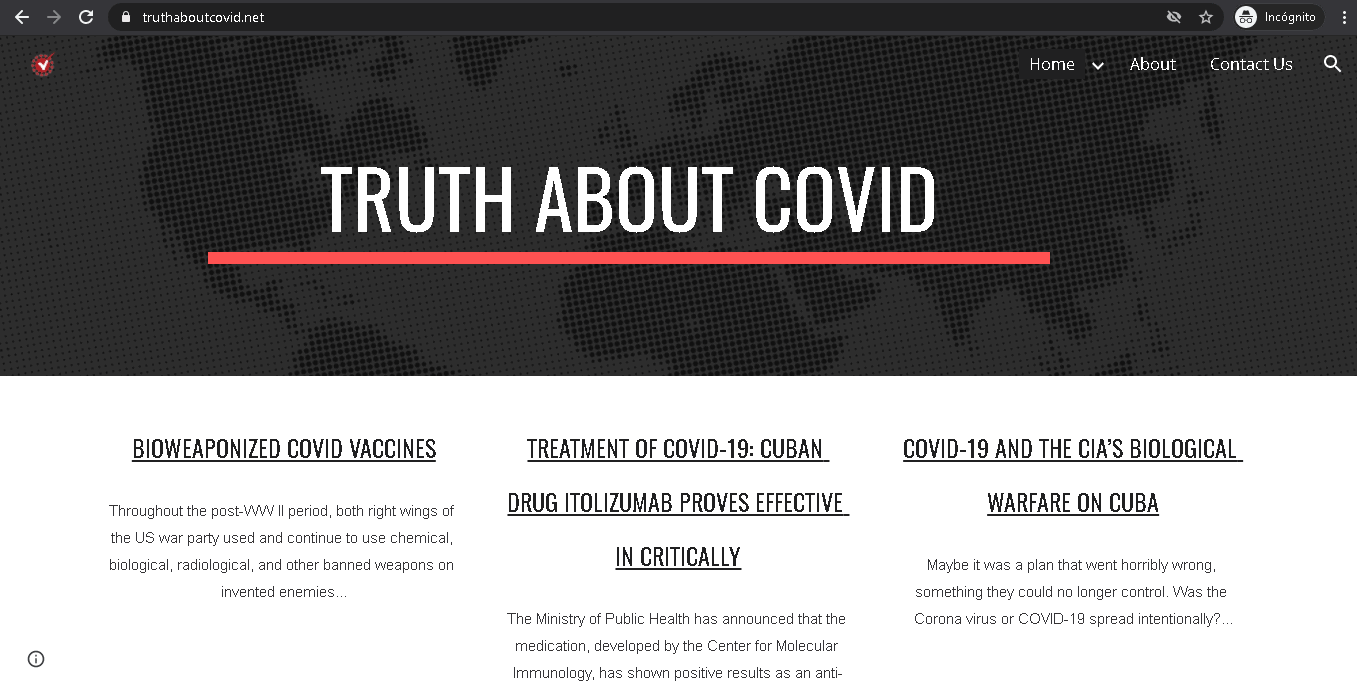
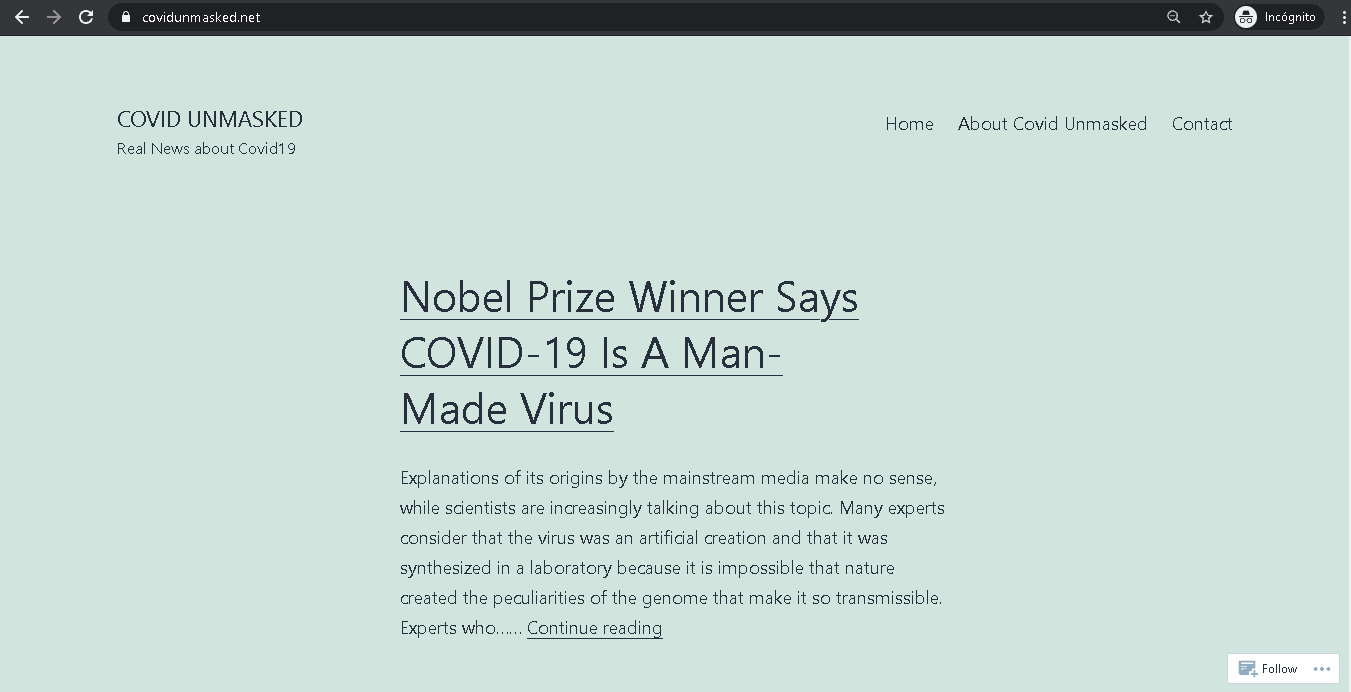
How to Report Misleading or Abusive Content to a Website Builder
After we published the sites, I personally researched the processes in place to report abuse to each of the website builders we tested. All of them post their terms and conditions or terms of service online for the public to see. Likewise, they all offer a way to report sites that contain harmful, dangerous, or illegal content. What they don’t have in common is how they decide what exactly is worthy of removal. I submitted a complaint to the website builder we used to make each fake news site, either by email or through an online contact form. In my report, I provided a link to the site and a short explanation of why I thought it should be taken down. In some cases, I also referenced a specific part of the terms and conditions to support my point. Once that was done, it was time to wait… and wait some more. After a couple of days, I followed up with the sites that had yet to respond, and sent another report from a different email address. After more than a week, fewer than half of the sites were removed. Some of the website builders didn’t provide any response or acknowledge my complaint at all.
Results – Which Website Builders Remove Misleading COVID-19 Content?
Of the seven website builders we tested, only two removed the site in question within the first week, and three provided a direct response to the report(s) I submitted. Below, I’ll explain the process and results for each website builder in detail.1. Squarespace
Squarespace is consistently ranked as one of the top website builders available, so we had high hopes for its customer service and abuse policy. I found the following section in its Acceptable Use Policy, which appears to clearly prohibit misinformation: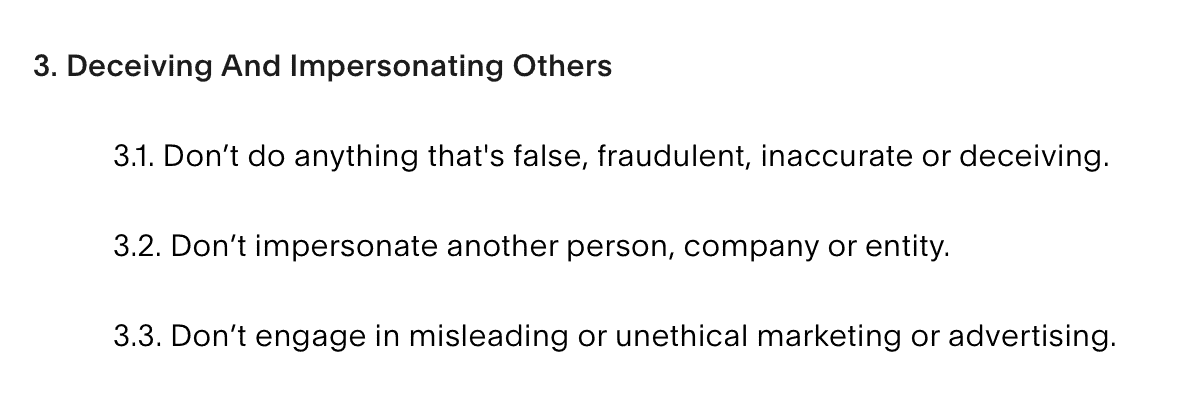
Screenshot from Squarespace’s Acceptable Use Policy.
To see if this policy applies to COVID-related fake news – which I would personally categorize as both misleading and unethical – I reported the site our team created using Squarespace. First, I sent an email to [email protected], as indicated in the Acceptable Use Policy, and immediately got an automated email letting me know my report was received.
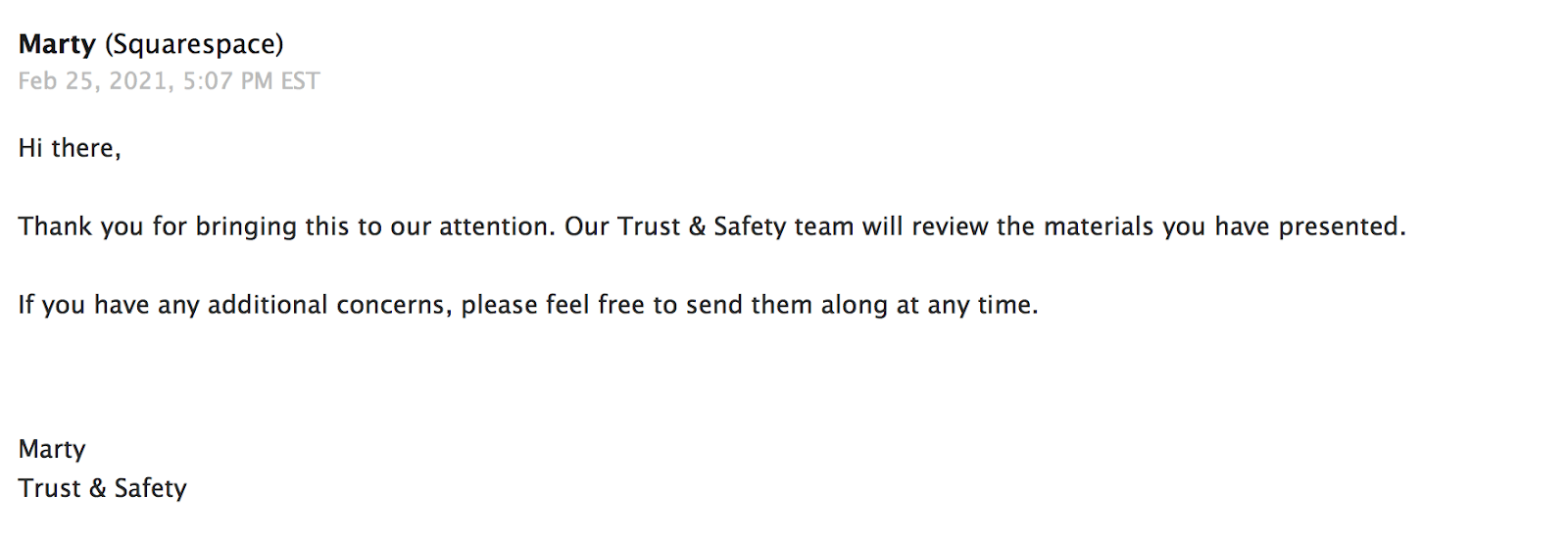 However, I never received any further information or follow-up. At the time of publication of this post, the fake news site remained live at Covidtruefacts.com. This was a surprising result from Squarespace, which ranks consistently well in terms of customer support – especially considering that it specifically prohibits false, inaccurate, misleading, and unethical content.
Note: Squarespace is headquartered in the United States, where many of the tech giants at the center of current debates about fake news are also based.
However, I never received any further information or follow-up. At the time of publication of this post, the fake news site remained live at Covidtruefacts.com. This was a surprising result from Squarespace, which ranks consistently well in terms of customer support – especially considering that it specifically prohibits false, inaccurate, misleading, and unethical content.
Note: Squarespace is headquartered in the United States, where many of the tech giants at the center of current debates about fake news are also based.
2. Weebly
Weebly’s Terms of Service do not explicitly prohibit fake news or false content, but they do include the open-ended statement highlighted below:
Screenshot from Weebly’s Terms of Service.
So Weebly reserves the right to remove any content that they find “objectionable.” But does that apply to COVID-related misinformation? Apparently so; the site we created with Weebly was the very first one to be taken down. Strangely, they did not notify us of its removal, but they did immediately issue a refund for the hosting fee.
3. WordPress.com
To test this popular service, we created a site using WordPress.com (not the open-source software of the same name) and connected it to the domain Covidunmasked.net. When it comes to removing content, WordPress may have the most open-ended policy of all the website builders we tested. Its Terms of Service include the following statement: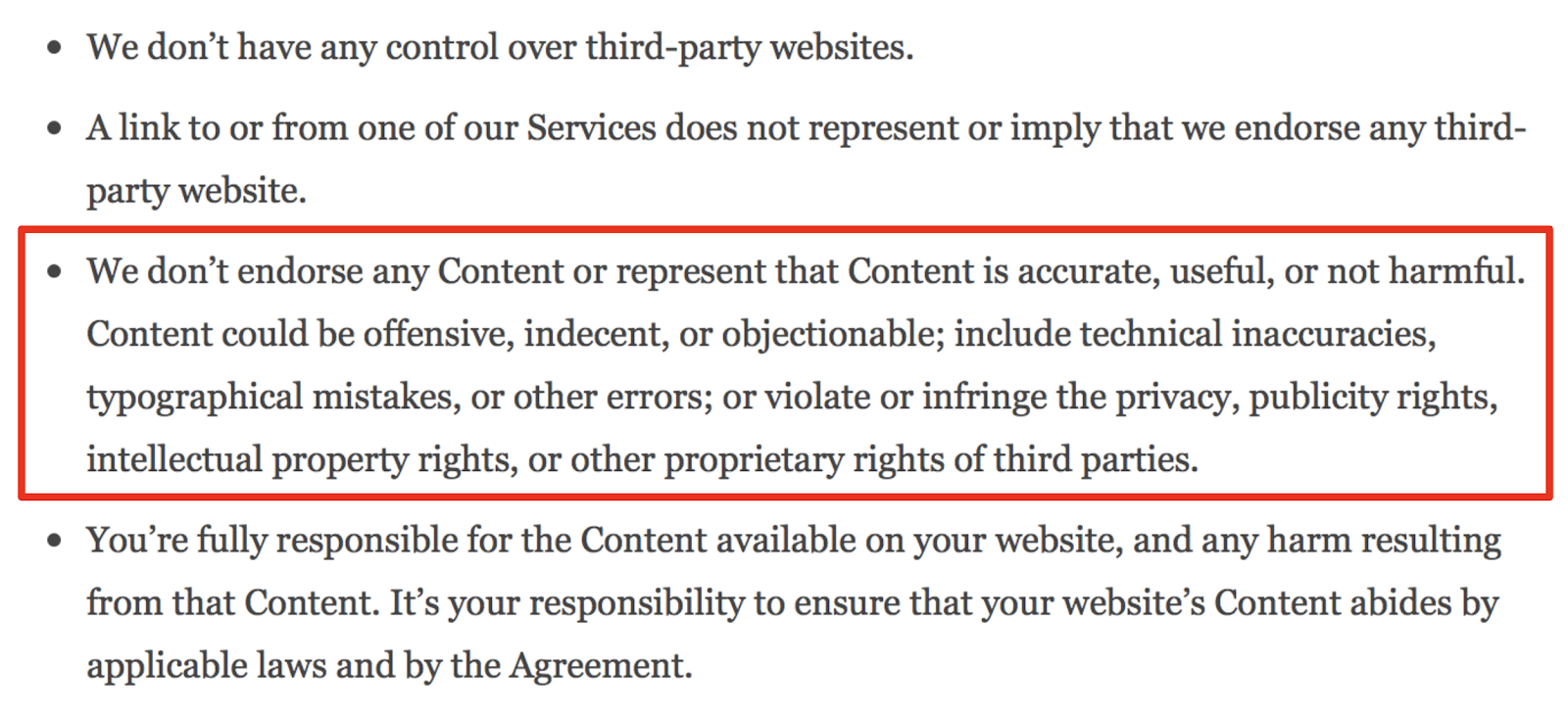
Screenshot from WordPress’ Terms of Service.
This could be interpreted as a purposely hands-off approach to conspiracy theories and other “objectionable content.” Indeed, WordPress has previously faced criticism – and from some, praise – for limiting content removal.
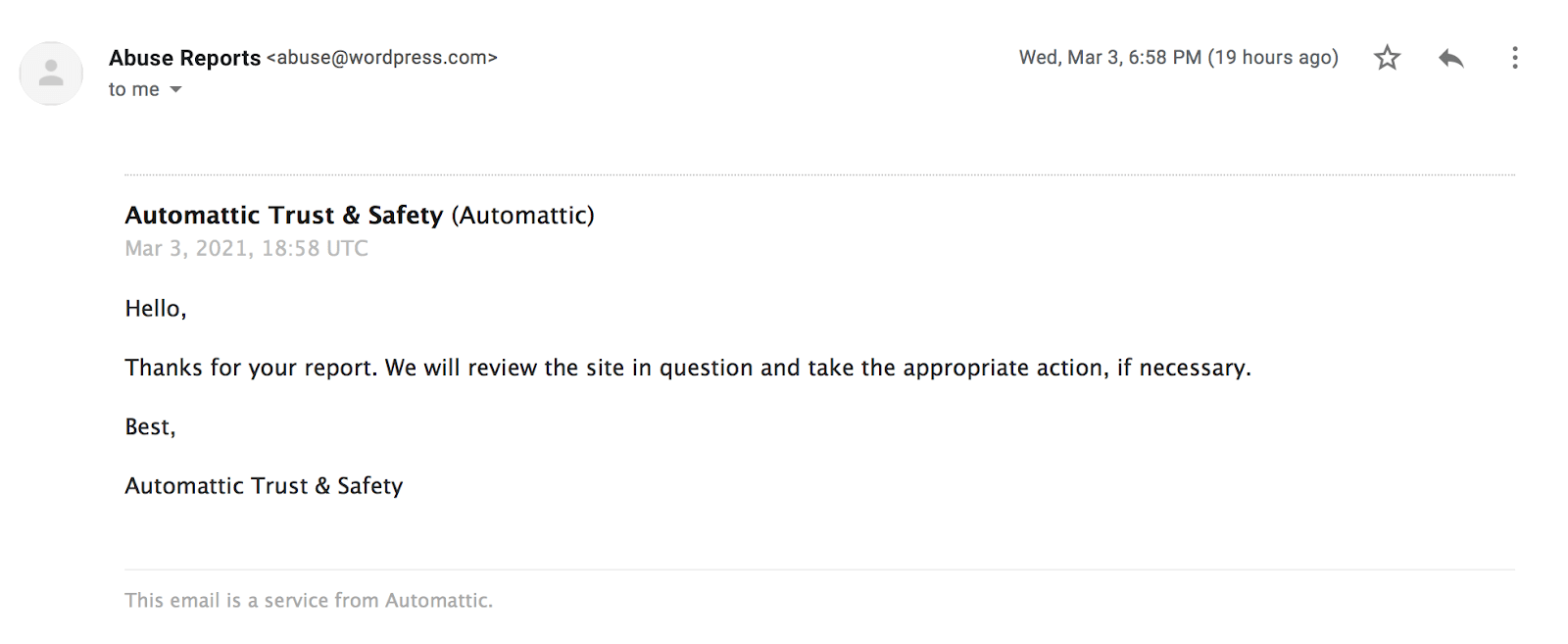 However, WordPress has not yet taken any further action or removed the fake news site. Overall, this was a disappointing outcome – but not exactly surprising, given the company’s history.
Note: WordPress is headquartered in the United States.
However, WordPress has not yet taken any further action or removed the fake news site. Overall, this was a disappointing outcome – but not exactly surprising, given the company’s history.
Note: WordPress is headquartered in the United States.
4. GoDaddy Website Builder
GoDaddy is the only website builder on this list advertising a specific COVID-related abuse policy, which includes the following:
Screenshot from GoDaddy’s COVID-related abuse policy.
GoDaddy asks users to submit reports of COVID-19 abuse or fraud through an online form or to their dedicated email address: [email protected]. I decided to go the email route to report our fake news site, which was at Thetruthishere.org.
 Apparently, GoDaddy doesn’t consider fake news to violate its COVID-related abuse policy.
Note: GoDaddy is headquartered in the United States.
*Despite the fact that this email identifies the company as a “hosting provider,” we used GoDaddy’s website building plan – not its hosting service – to create the fake news site.
Apparently, GoDaddy doesn’t consider fake news to violate its COVID-related abuse policy.
Note: GoDaddy is headquartered in the United States.
*Despite the fact that this email identifies the company as a “hosting provider,” we used GoDaddy’s website building plan – not its hosting service – to create the fake news site.
5. Webnode
Webnode’s Terms and Conditions state the following: “Materials that somehow violate or infringe, in any way, on Our rights or on the rights of others (including but not limited to intellectual property rights, confidentiality rights and privacy rights) are absolutely forbidden, as well as activities that may cause distress or inconvenience on Us or others.”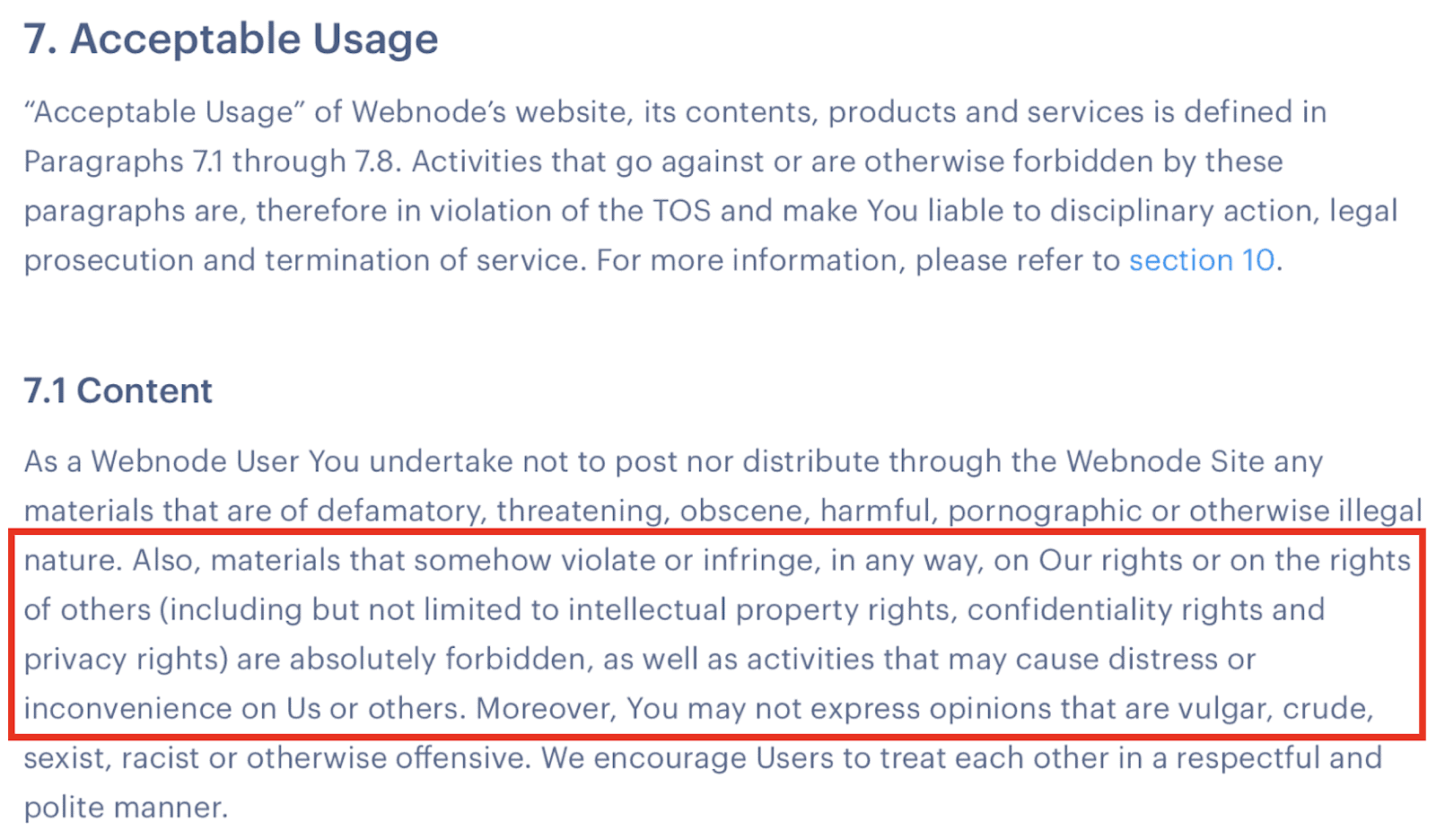
Screenshot from Webnode’s Terms and Conditions.
These terms may not specifically address misinformation, but it could certainly be argued that the last part of this sentence applies to COVID-related fake news. I reported our site by sending an email to the address indicated here to “report abuse.”
 I responded to this email, pointing out the specific section of the terms and conditions referenced above, and including this question:
“Would you not agree that a website claiming that ‘the entire COVID pandemic is nothing more than a hoax based on false statistics’ may cause exceptional distress, not to mention threaten the public by spreading distrust in the global health system?”
Just over two hours later, I received this response:
I responded to this email, pointing out the specific section of the terms and conditions referenced above, and including this question:
“Would you not agree that a website claiming that ‘the entire COVID pandemic is nothing more than a hoax based on false statistics’ may cause exceptional distress, not to mention threaten the public by spreading distrust in the global health system?”
Just over two hours later, I received this response:
 Webnode refused to remove the site, which was at Covidinvestigated.com, because it does not clearly violate their terms and conditions. They seem to be defending the content on the basis of free speech, as it “contains an opinion.”
This appears to be the same stance that WordPress takes, but it’s worth mentioning that sites like Facebook and Twitter do not require an official court order or police request to remove misleading content.
Note: Webnode is based in the Czech Republic. Disinformation has become a serious problem in the country recently, especially as related to the COVID-19 pandemic.
Webnode refused to remove the site, which was at Covidinvestigated.com, because it does not clearly violate their terms and conditions. They seem to be defending the content on the basis of free speech, as it “contains an opinion.”
This appears to be the same stance that WordPress takes, but it’s worth mentioning that sites like Facebook and Twitter do not require an official court order or police request to remove misleading content.
Note: Webnode is based in the Czech Republic. Disinformation has become a serious problem in the country recently, especially as related to the COVID-19 pandemic.
6. Jimdo
Jimdo’s Terms of Service explicitly prohibit “content and/or communications that are deemed to promote and/or support racism, radicalism, fascism, fanaticism, hate, physical and psychological violence or illegal activity (whether explicit or implicit) or that otherwise breach the standards of common decency.”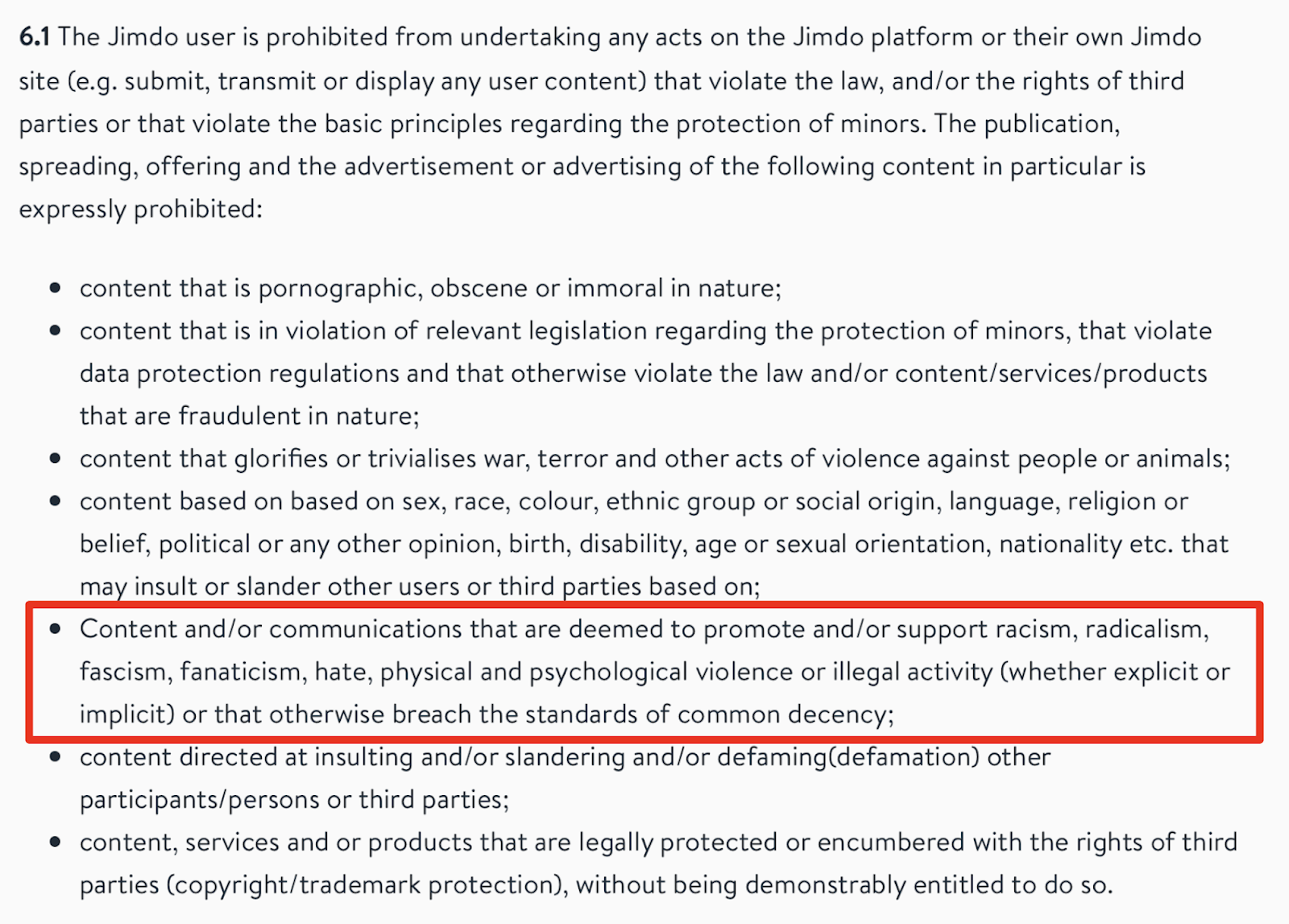
Screenshot from Jimdo’s Terms of Service.
I submitted a form to report abuse through their website, specifically drawing their attention to the last part of the section above. There was no automatic confirmation that my report was received, but the next day, a representative from the Jimdo Anti-Abuse Team sent me the following email:
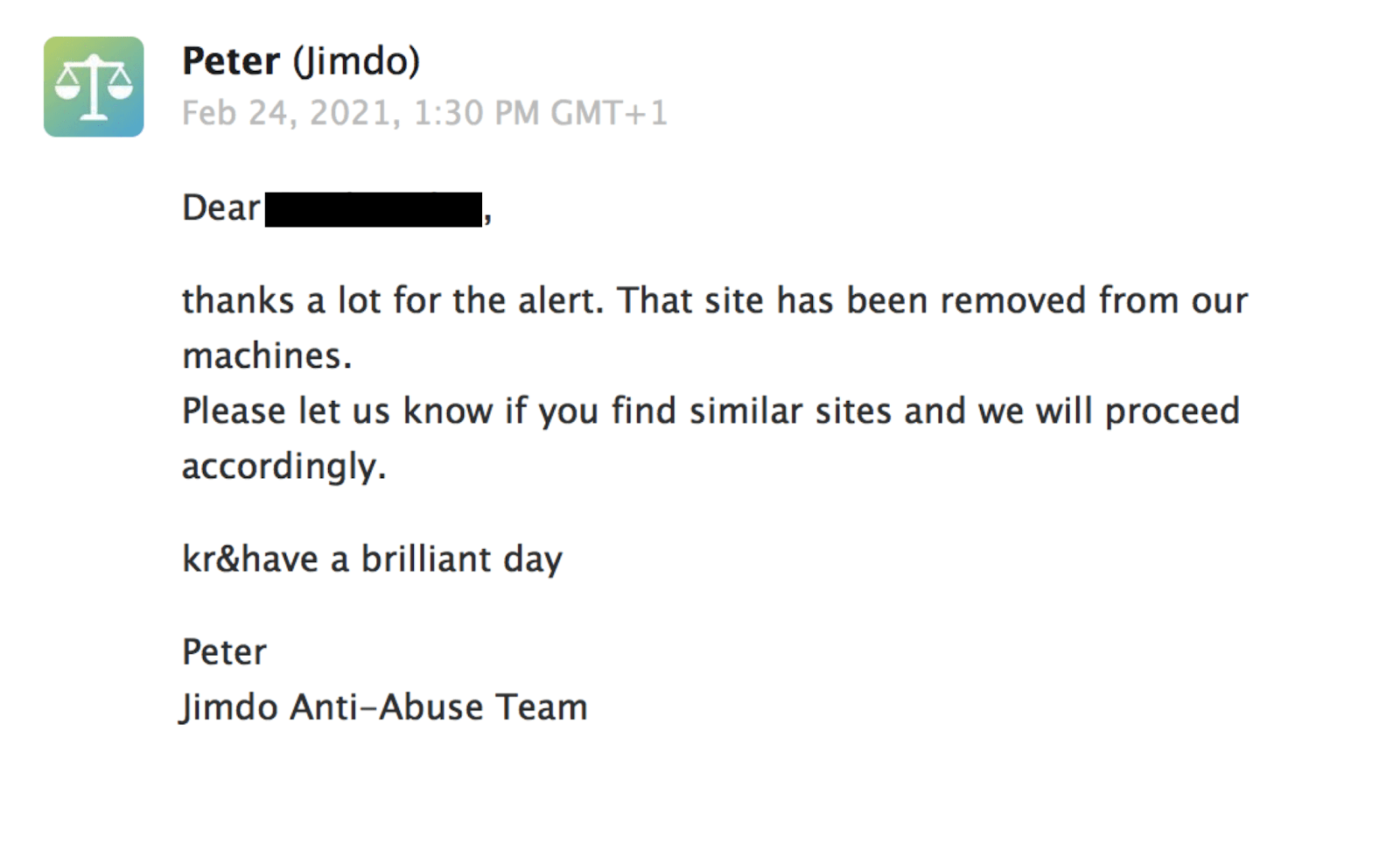 This was an impressively prompt and effective response, proving that Jimdo takes misinformation seriously and is willing to take quick and decisive action against it – no court order required.
They also sent an email to the owner of the site (us) to let us know that it had been taken down, and refunded our payment “as a gesture of goodwill.”
This was an impressively prompt and effective response, proving that Jimdo takes misinformation seriously and is willing to take quick and decisive action against it – no court order required.
They also sent an email to the owner of the site (us) to let us know that it had been taken down, and refunded our payment “as a gesture of goodwill.”
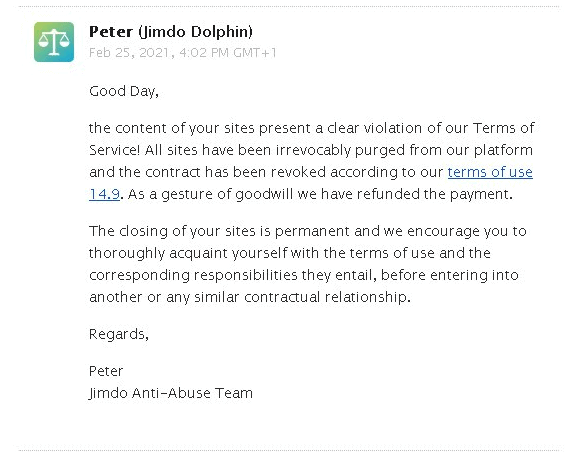 Overall, Jimdo had the best response to COVID-19 misinformation of all the website builders we tested. It was the only one that responded to my report, took down the site (which was at Coronatruecolors.com), and notified the owner that the site was removed. In my opinion, this should be standard procedure for all website builders when confronted with reports of fake news.
Note: Jimdo is based in Germany, which has one of the strictest – and most controversial – policies against online hate speech. The country has responded to criticism for restricting freedom of expression by increasing transparency, while continuing to enforce and even expand its rules.
Overall, Jimdo had the best response to COVID-19 misinformation of all the website builders we tested. It was the only one that responded to my report, took down the site (which was at Coronatruecolors.com), and notified the owner that the site was removed. In my opinion, this should be standard procedure for all website builders when confronted with reports of fake news.
Note: Jimdo is based in Germany, which has one of the strictest – and most controversial – policies against online hate speech. The country has responded to criticism for restricting freedom of expression by increasing transparency, while continuing to enforce and even expand its rules.
7. Google Sites
Google Sites has an automated system for reporting abuse on its websites. All you have to do is click on the information symbol in the lower right-hand corner of the site, and then click “Report abuse.”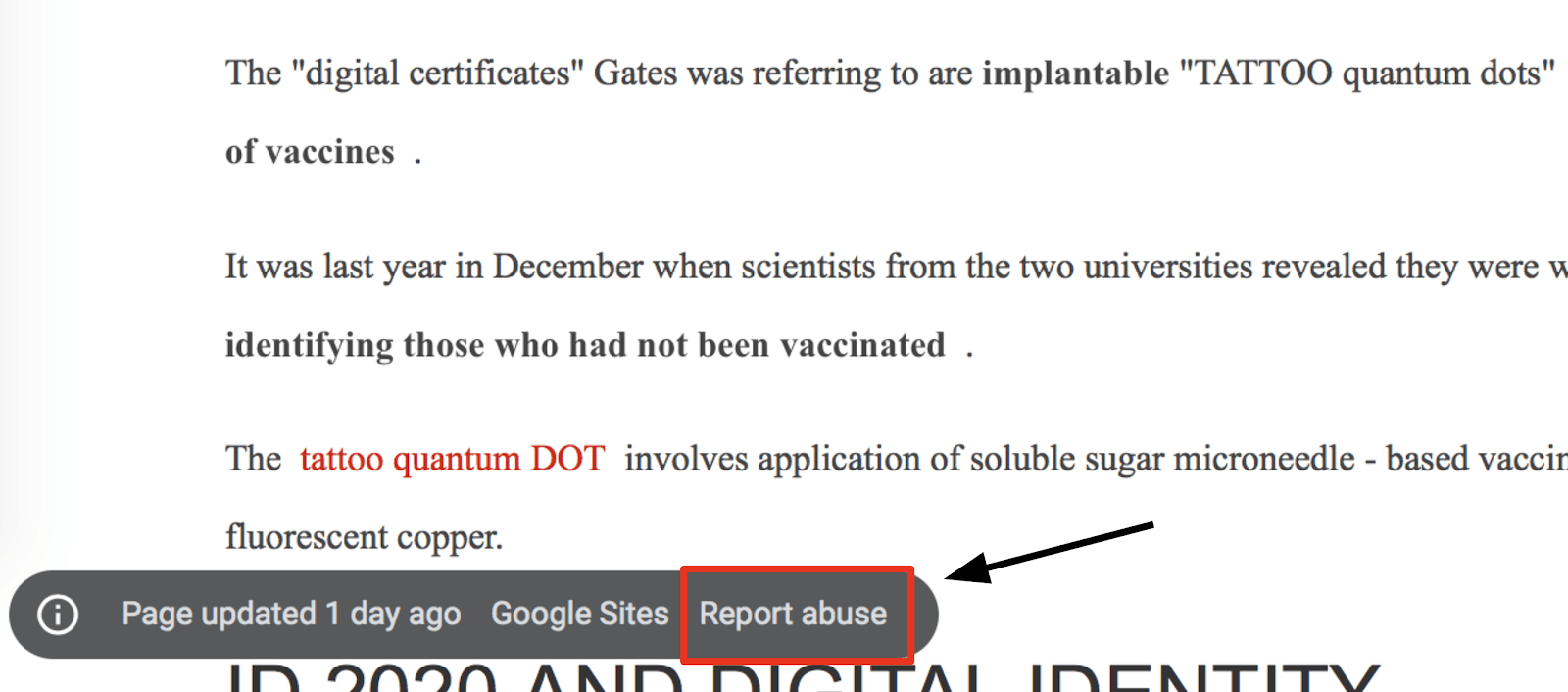
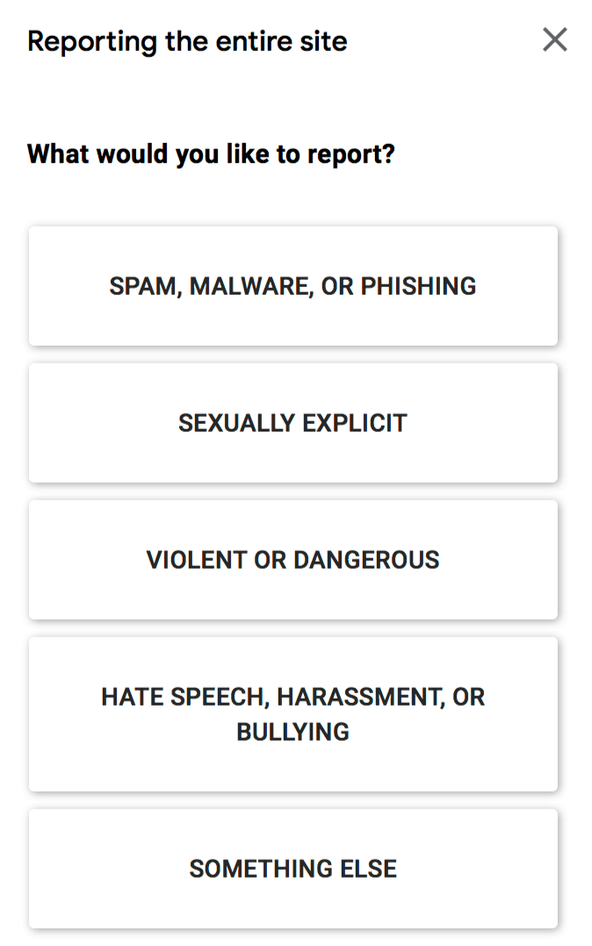 |
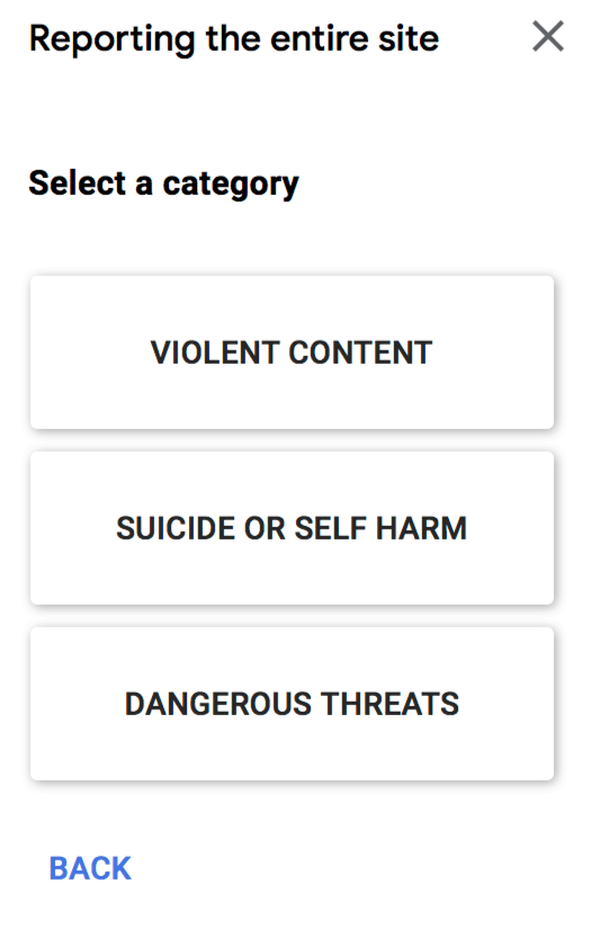 |
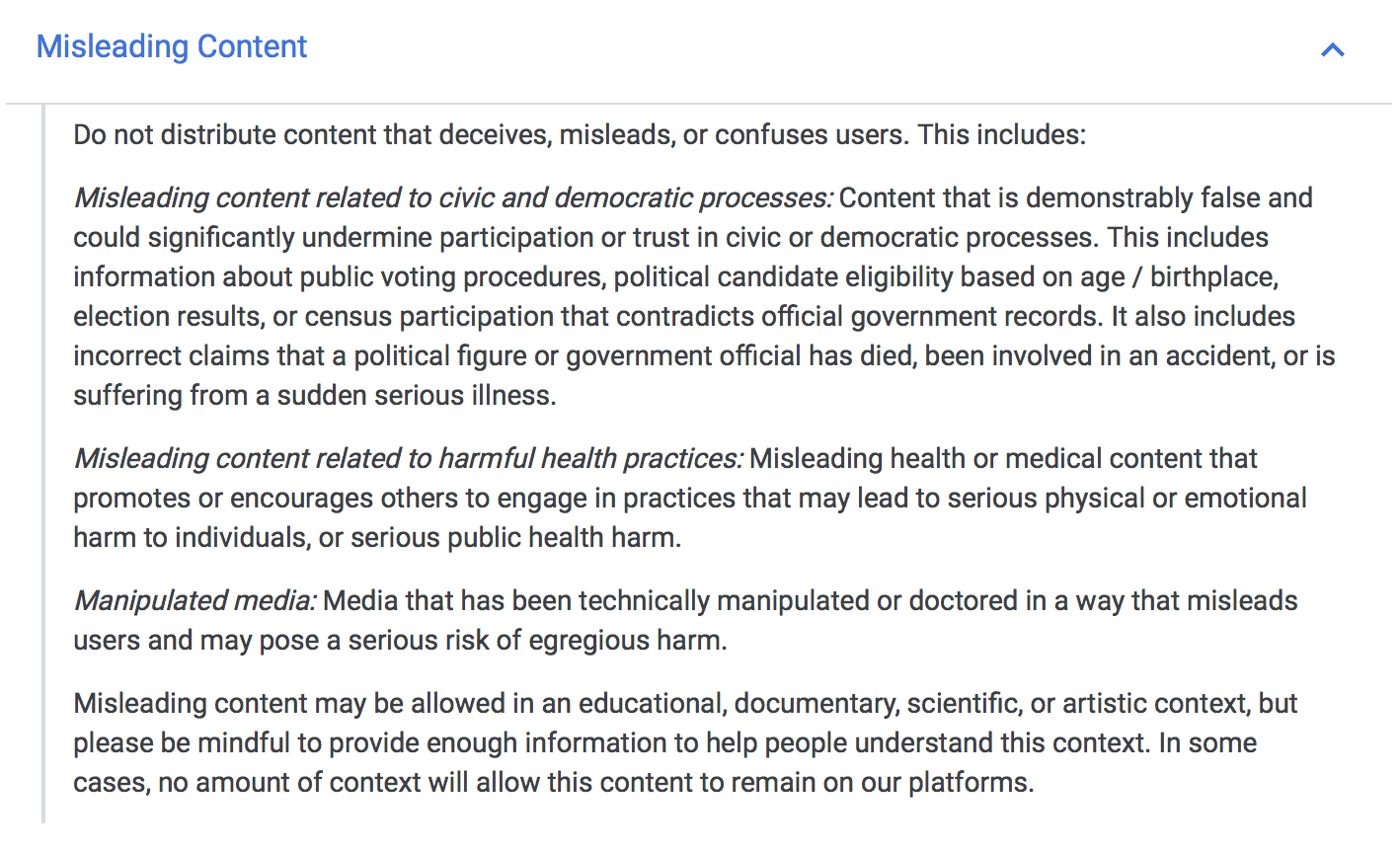 I looked through every single category provided, and the closest matches I could find were “dangerous threats” and “violent content.” I reported the site, which was connected to the domain Truthaboutcovid19.net, for both of these violations, but it felt a bit like shouting into the abyss. I didn’t receive any communication from Google – and I don’t expect to, since the form didn’t even require me to input my email address.
So far, Google Sites has yet to take down our COVID fake news site.
Note: Google is headquartered in the United States.
I looked through every single category provided, and the closest matches I could find were “dangerous threats” and “violent content.” I reported the site, which was connected to the domain Truthaboutcovid19.net, for both of these violations, but it felt a bit like shouting into the abyss. I didn’t receive any communication from Google – and I don’t expect to, since the form didn’t even require me to input my email address.
So far, Google Sites has yet to take down our COVID fake news site.
Note: Google is headquartered in the United States.














